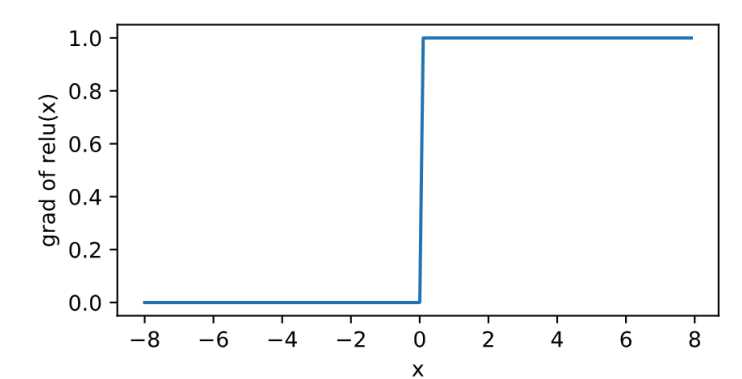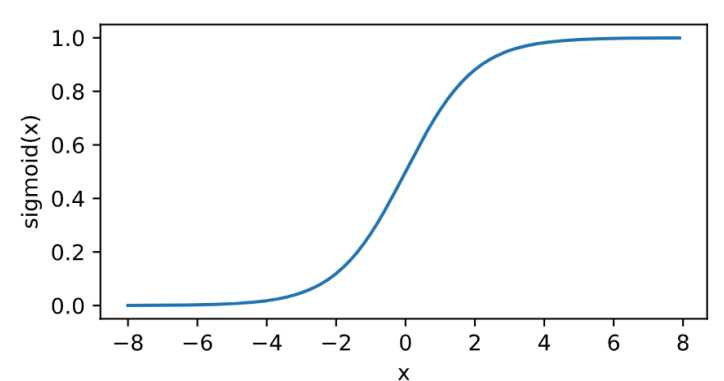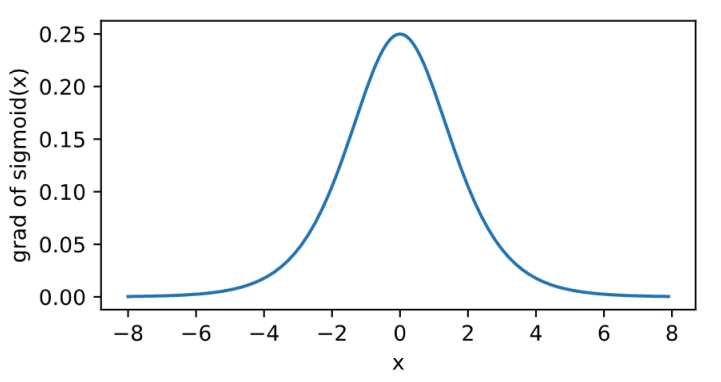标签:tail 视觉 module forms 调整 visio padding start epg
AlexNet是2012年提出的一个模型,并且赢得了ImageNet图像识别挑战赛的冠军.首次证明了由计算机自动学习到的特征可以超越手工设计的特征,对计算机视觉的研究有着极其重要的意义.
AlexNet的设计思路和LeNet是非常类似的.不同点主要有以下几点:
\[\text{ReLU}(x) = \max(x, 0).\]
其曲线及导数的曲线图绘制如下:


其曲线及导数的曲线图绘制如下:
\[\text{sigmoid}(x) = \frac{1}{1 + \exp(-x)}.\]


relu的好处主要有两点:
现在大多模型激活函数都选择Relu了.
AlexNet结构如下:

早期的硬件设备计算能力不足,所以上面的图分成了两部分,把不同部分的计算分散到不同的gpu上去,现在已经完全没有这种必要了.比如第一个卷积层的channel是48 x 2 = 96个.
根据上图,我们来写模型的定义:
首先,用一个11 x 11的卷积核,对224 x 224的输入,卷积后得到55 x 55 x 96的输出.
由于我们的图片是单通道的,那么我们有代码:
nn.Conv2d(1, 96, kernel_size=11, stride=4)然而,我们测试一下他的输出.
X=torch.randn((1,1,224,224)) #batch x c x h x w
net = nn.Conv2d(1, 96, kernel_size=11, stride=4)
out = net(X)
print(out.shape)输出
torch.Size([1, 96, 54, 54])我们将代码修改为
nn.Conv2d(3, 64, kernel_size=11, stride=4, padding=2)再用相同的代码测试输出
X=torch.randn((1,1,224,224)) #batch x c x h x w
net = nn.Conv2d(1, 96, kernel_size=11, stride=4,padding=2)
out = net(X)
print(out.shape)输出
torch.Size([1, 96, 55, 55])由此可见,第一个卷积层的实现应该是
nn.Conv2d(3, 64, kernel_size=11, stride=4, padding=2)搜索pytorch的padding策略,https://blog.csdn.net/g11d111/article/details/82665265基本都是抄这篇的,这篇里指出
显然,padding=1的效果是:原来的输入层基础上,上下左右各补了一行!
然而实测和文章中的描述不一致.
net = nn.Conv2d(1, 1, 3,padding=0)
X= torch.randn((1,1,5,5))
print(X)
out=net(X)
print(out)
net2 = nn.Conv2d(1, 1, 3,padding=1)
out=net(X)
print(out)输出
tensor([[[[-2.3052, 0.7220, 0.3106, 0.0605, -0.8304],
[-0.0831, 0.0168, -0.9227, 2.2891, 0.6738],
[-0.7871, -0.2234, -0.2356, 0.2500, 0.8389],
[ 0.7070, 1.1909, 0.2963, -0.7580, 0.1535],
[ 1.0306, -1.1829, 3.1201, 1.0544, 0.3521]]]])
tensor([[[[-0.1129, 0.7711, -0.6452],
[-0.3387, 0.1025, 0.3039],
[ 0.1604, 0.2709, 0.0740]]]], grad_fn=<MkldnnConvolutionBackward>)
tensor([[[[-0.1129, 0.7711, -0.6452],
[-0.3387, 0.1025, 0.3039],
[ 0.1604, 0.2709, 0.0740]]]], grad_fn=<MkldnnConvolutionBackward>)到目前,我也没有把torch的padding策略搞清楚.知道的同学请评论留言.我的torch版本是1.2.0
AlexNet的激活函数采用的是Relu,所以
nn.ReLU(inplace=True)接下来用一个3 x 3的卷积核去做最大池化,步幅为2,得到[27,27,96]的输出
nn.MaxPool2d(kernel_size=3, stride=2)我们测试一下:
X=torch.randn((1,1,224,224)) #batch x c x h x w
net = nn.Sequential(
nn.Conv2d(1, 96, kernel_size=11, stride=4,padding=2),
nn.ReLU(),
nn.MaxPool2d(kernel_size=3,stride=2)
)
out = net(X)
print(out.shape)输出
torch.Size([1, 96, 27, 27])至此,一个基本的卷积单元的定义就完成了,包括卷积,激活,池化.类似的,我们可以写出后续各层的定义.
AlexNet有5个卷积层,第一个卷积层的卷积核大小为11x11,第二个卷积层的卷积核大小为5x5,其余的卷积核均为3x3.第一二五个卷积层后做了最大池化操作,窗口大小为3x3,步幅为2.
这样,卷积层的部分如下:
net = nn.Sequential(
nn.Conv2d(1, 96, kernel_size=11, stride=4,padding=2), #[1,96,55,55] order:batch,channel,h,w
nn.ReLU(),
nn.MaxPool2d(kernel_size=3,stride=2), #[1,96,27,27]
nn.Conv2d(96, 256, kernel_size=5, stride=1,padding=2),#[1,256,27,27]
nn.ReLU(),
nn.MaxPool2d(kernel_size=3,stride=2), #[1,256,13,13]
nn.Conv2d(256, 384, kernel_size=3, stride=1,padding=1), #[1,384,13,13]
nn.ReLU(),
nn.Conv2d(384, 384, kernel_size=3, stride=1,padding=1), #[1,384,13,13]
nn.ReLU(),
nn.Conv2d(384, 256, kernel_size=3, stride=1,padding=1), #[1,256,13,13]
nn.ReLU(),
nn.MaxPool2d(kernel_size=3,stride=2), #[1,256,6,6]
)接下来是全连接层的部分:
net = nn.Sequential(
nn.Linear(256*6*6,4096),
nn.ReLU(),
nn.Dropout(0.5), #dropout防止过拟合
nn.Linear(4096,4096),
nn.ReLU(),
nn.Dropout(0.5), #dropout防止过拟合
nn.Linear(4096,10) #我们最终要10分类
)全连接层的参数数量过多,为了防止过拟合,我们在激活层后面加入了dropout层.
这样的话我们就可以给出模型定义:
class AlexNet(nn.Module):
def __init__(self):
super(AlexNet, self).__init__()
self.conv = nn.Sequential(
nn.Conv2d(1, 96, kernel_size=11, stride=4, padding=2), # [1,96,55,55] order:batch,channel,h,w
nn.ReLU(),
nn.MaxPool2d(kernel_size=3, stride=2), # [1,96,27,27]
nn.Conv2d(96, 256, kernel_size=5, stride=1,padding=2), # [1,256,27,27]
nn.ReLU(),
nn.MaxPool2d(kernel_size=3, stride=2), # [1,256,13,13]
nn.Conv2d(256, 384, kernel_size=3, stride=1,padding=1), # [1,384,13,13]
nn.ReLU(),
nn.Conv2d(384, 384, kernel_size=3, stride=1,padding=1), # [1,384,13,13]
nn.ReLU(),
nn.Conv2d(384, 256, kernel_size=3, stride=1,padding=1), # [1,256,13,13]
nn.ReLU(),
nn.MaxPool2d(kernel_size=3, stride=2), # [1,256,6,6]
)
self.fc = nn.Sequential(
nn.Linear(256*6*6, 4096),
nn.ReLU(),
nn.Dropout(0.5), # dropout防止过拟合
nn.Linear(4096, 4096),
nn.ReLU(),
nn.Dropout(0.5), # dropout防止过拟合
nn.Linear(4096, 10) # 我们最终要10分类
)
def forward(self, img):
feature = self.conv(img)
output = self.fc(feature.view(img.shape[0], -1))#输入全连接层之前,将特征展平
return output
batch_size,num_workers=32,4
train_iter,test_iter = learntorch_utils.load_data(batch_size,num_workers,resize=224)其中load_data定义于learntorch_utils.py.
def load_data(batch_size,num_workers,resize):
trans = []
if resize:
trans.append(torchvision.transforms.Resize(size=resize))
trans.append(torchvision.transforms.ToTensor())
transform = torchvision.transforms.Compose(trans)
mnist_train = torchvision.datasets.FashionMNIST(root='/home/sc/disk/keepgoing/learn_pytorch/Datasets/FashionMNIST',
train=True, download=True,
transform=transform)
mnist_test = torchvision.datasets.FashionMNIST(root='/home/sc/disk/keepgoing/learn_pytorch/Datasets/FashionMNIST',
train=False, download=True,
transform=transform)
train_iter = torch.utils.data.DataLoader(
mnist_train, batch_size=batch_size, shuffle=True, num_workers=num_workers)
test_iter = torch.utils.data.DataLoader(
mnist_test, batch_size=batch_size, shuffle=False, num_workers=num_workers)
return train_iter,test_iter这里,构造了一个transform.对图像做一次resize.
if resize:
trans.append(torchvision.transforms.Resize(size=resize))
trans.append(torchvision.transforms.ToTensor())
transform = torchvision.transforms.Compose(trans)net = AlexNet().cuda()由于全连接层的存在,AlexNet的参数还是非常多的.所以我们使用GPU做运算
loss = nn.CrossEntropyLoss()opt = torch.optim.Adam(net.parameters(),lr=0.01)def test():
acc_sum = 0
batch = 0
for X,y in test_iter:
X,y = X.cuda(),y.cuda()
y_hat = net(X)
acc_sum += (y_hat.argmax(dim=1) == y).float().sum().item()
batch += 1
print('acc_sum %d,batch %d' % (acc_sum,batch))
return 1.0*acc_sum/(batch*batch_size)验证在测试集上的准确率.
num_epochs = 3
def train():
for epoch in range(num_epochs):
train_l_sum,batch = 0,0
start = time.time()
for X,y in train_iter:
X,y = X.cuda(),y.cuda()
y_hat = net(X)
l = loss(y_hat,y)
opt.zero_grad()
l.backward()
opt.step()
train_l_sum += l.item()
batch += 1
test_acc = test()
end = time.time()
time_per_epoch = end - start
print('epoch %d,train_loss %f,test_acc %f,time %f' %
(epoch + 1,train_l_sum/(batch*batch_size),test_acc,time_per_epoch))
train()输出
acc_sum 6297,batch 313
epoch 1,train_loss 54.029241,test_acc 0.628694,time 238.983008
acc_sum 980,batch 313
epoch 2,train_loss 0.106785,test_acc 0.097843,time 239.722055
acc_sum 1000,batch 313
epoch 3,train_loss 0.071997,test_acc 0.099840,time 239.459902明显出现了过拟合.我们把学习率调整为0.001后,把batch_size调整为128
opt = torch.optim.Adam(net.parameters(),lr=0.001)再训练,输出
acc_sum 8714,batch 79
epoch 1,train_loss 0.004351,test_acc 0.861748,time 156.573509
acc_sum 8813,batch 79
epoch 2,train_loss 0.002473,test_acc 0.871539,time 201.961380
acc_sum 8958,batch 79
epoch 3,train_loss 0.002159,test_acc 0.885878,time 202.349568过拟合消失. 同时可以看到AlexNet由于参数过多,训练还是挺慢的.
标签:tail 视觉 module forms 调整 visio padding start epg
原文地址:https://www.cnblogs.com/sdu20112013/p/12168139.html